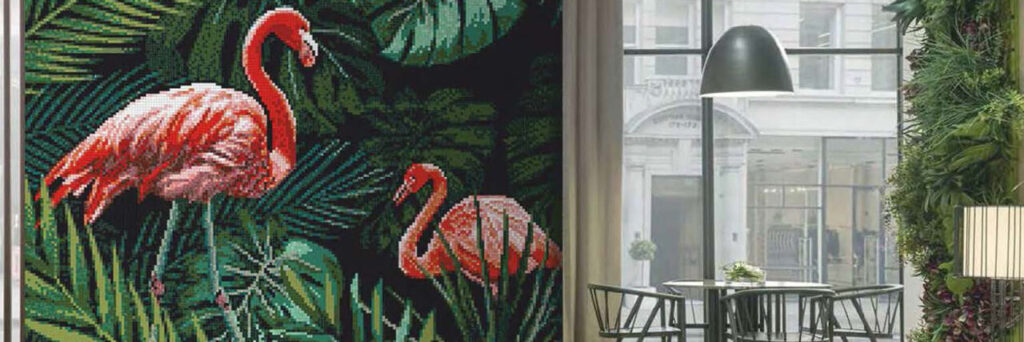
Art, Health and Ethics:
The Story of Sharron T and Tailored Art Works
What is Art? What does Art do? Sharron T’s Story
Hello. My name is Sharron, CEO of Tailored Art Works!. I am a Illustrator and Graphic Designer, Professional Artist, Interior Decorator, Colour Psychologist who became an Environmental Design specialist living and working in Brisbane, Australia. This is my story on how I ended up focusing on Art for Health Care and product design for dementia.

My story began when I was around 7, wondering what art is and what art does. After school when I was working in advertising, I revolted against the mass-produced making everything original. Later, I learned interior decorating and did cosmetic home renovations. Since then, I have gone corporate, to focus on Art, Health and Well-being to deliver more home-like institutional designs.
Something was driving me away from the norm. Why I didn’t I make my life easier and just paint for the galleries like every other artist?
London, Brisbane – advertising, design. For 23 years, I worked either full-time or freelance in ad agencies and design studios in Brisbane and London. My last boss, Carlo Marchese, asked me to create art for healthcare clients and charity auctions. I found this gratifying because clients said that the artworks created workplace well-being. I had always been torn between design and art feeling like there was something missing. I started a family but felt bored and so decided it was time to expand my skills.
The birth of Tailored Art Works. My dearest friend Tracie Rodwell Dunne suggested I do her Beaumont School Interior Decorating and Colour Psychology courses to learn how to create Art for Interior Designers. Now, I am a disruptor. I don’t like the gallery system of business and as a Dyslexic Thinker, I am a free thinker. The Impressionists were disruptors too. Turning art from social commentary and rigid rules into pretty pictures that made people feel good by appreciating beauty and life. Based on my new learnings, I decided that art and health combined through Colour Psychology and the rules of Interior Decorating would both inspire and up-cycle environments for Home and Workplace Well-being. I became a Art Stylist using art to give spaces an entirely new look!
There are two philosophies in buying Art. Either you love it, or you match it. Most people’s homes – and Aged Care Facilities too, – are embarrassingly unordered spaces from people DIYing. All it takes is education. Yet, the galleries and art critics advise that you should never buy art to match furniture – only art you love. Why buy art you love that disrupts your space? Why not match and be loved? Art can be made art to declutter a space and create better mental health for everyone. Art creates the illusion of more space, a connection to culture, architectural expression, a focal point, colour, texture, relevance and soul. Life without art feels cold and commercial. For Aged Care and Health Care, it is art and health combined that is the missing link to create home-like spaces of well-being.
Exhibitions from 2009-2021 with mum, friends and designers
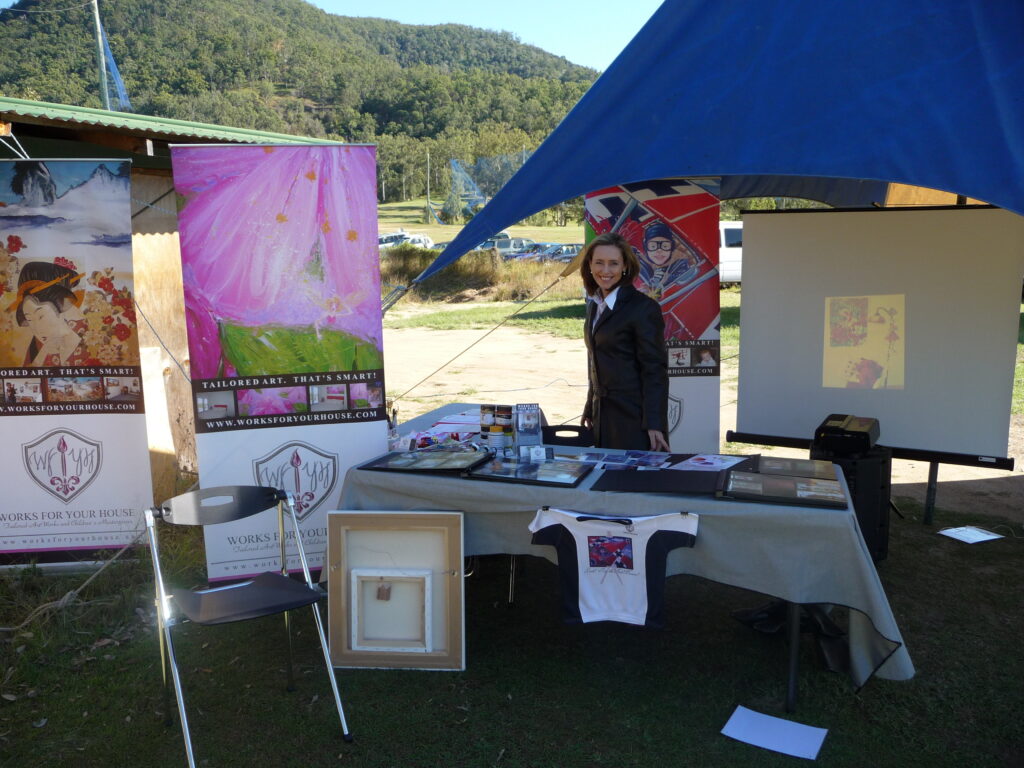
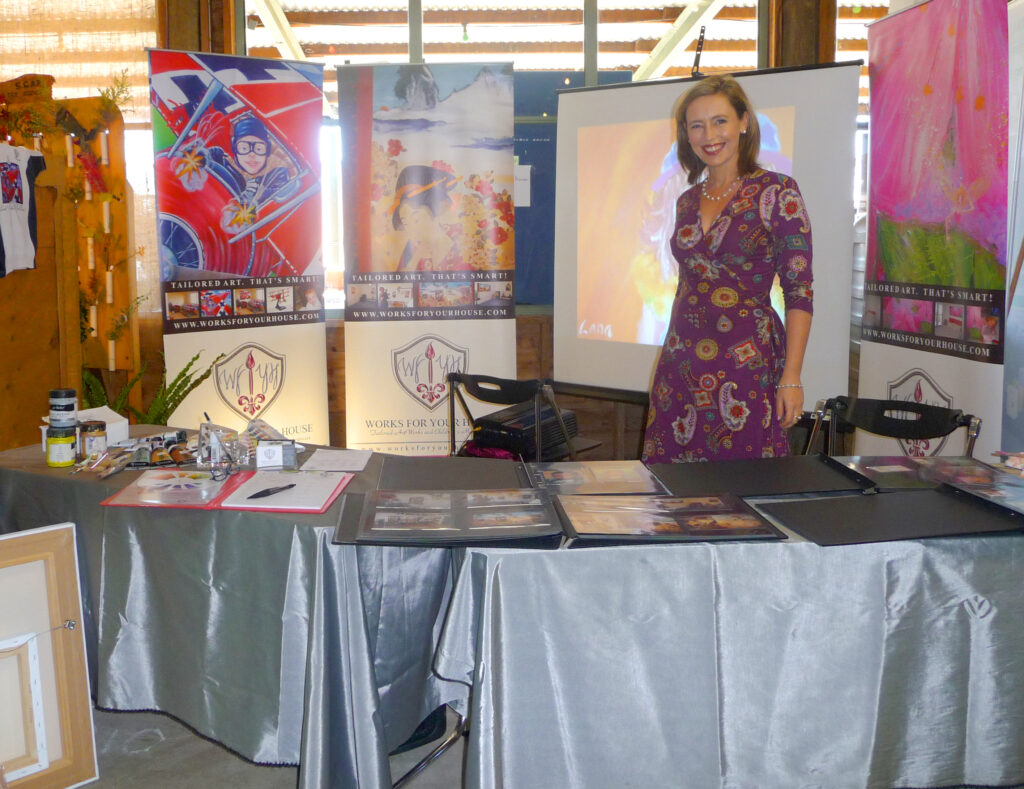
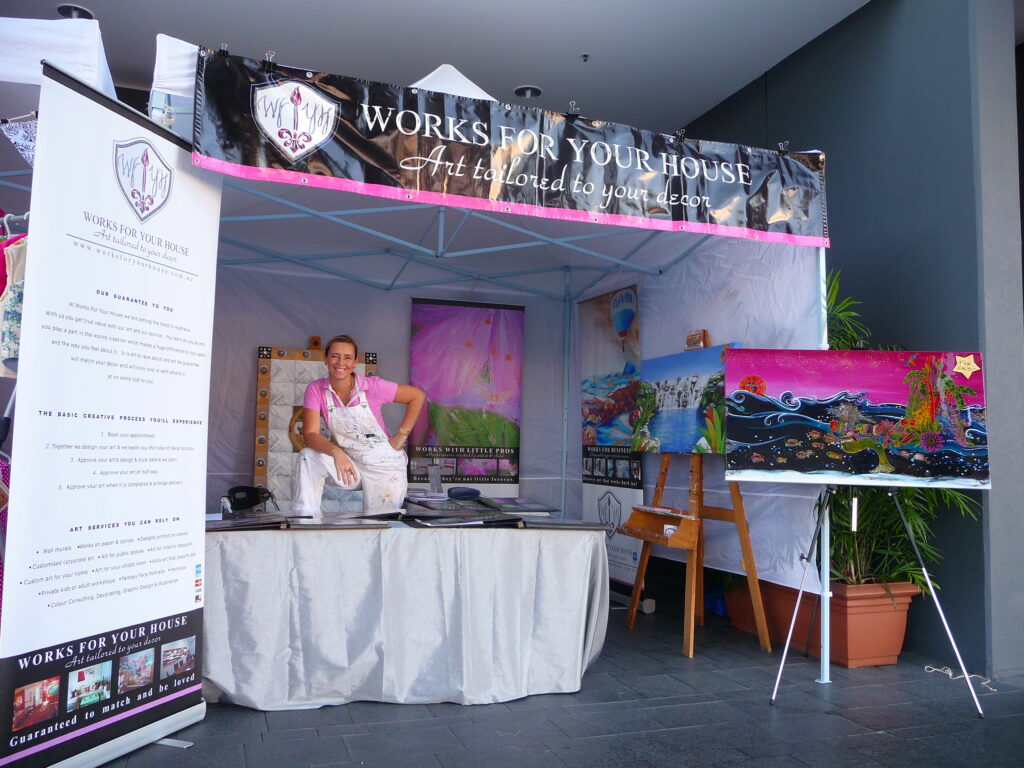

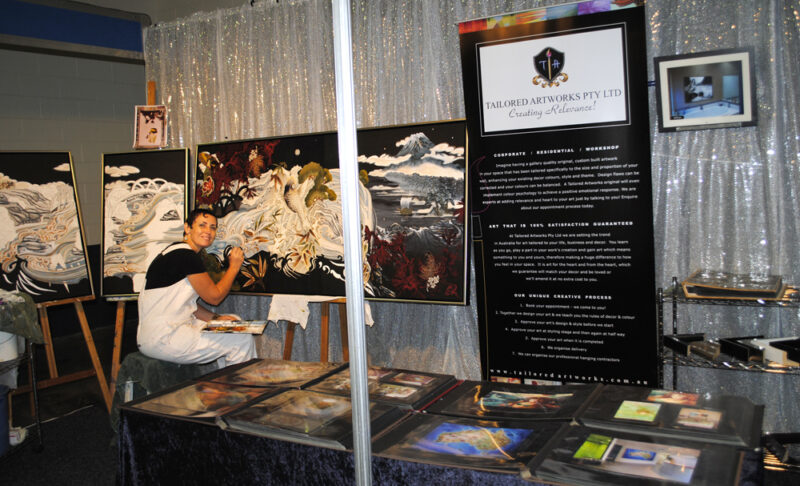
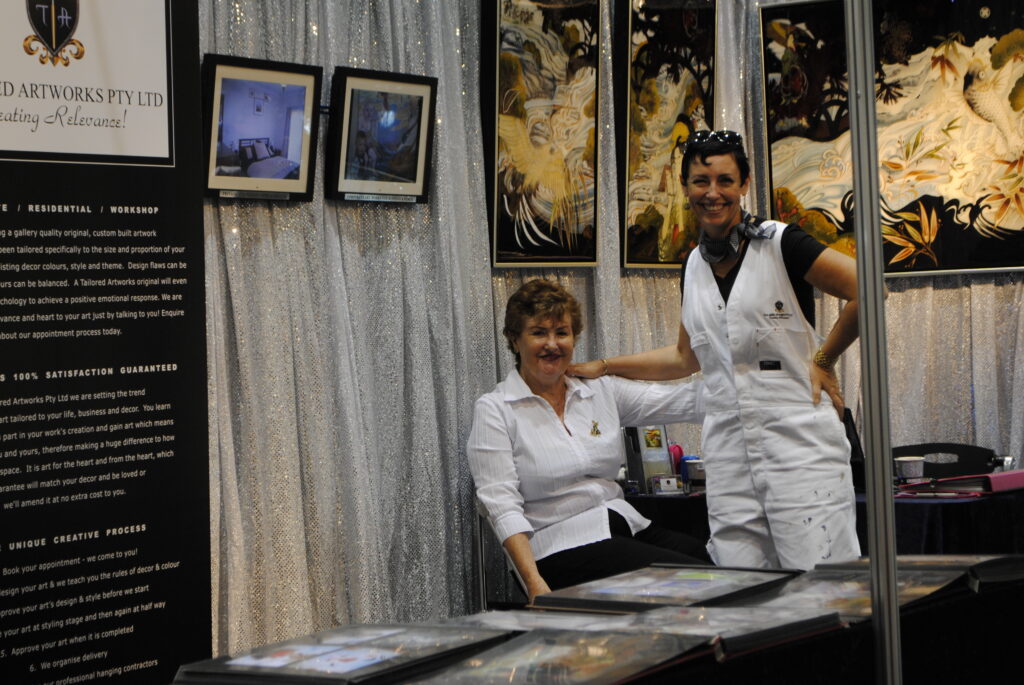


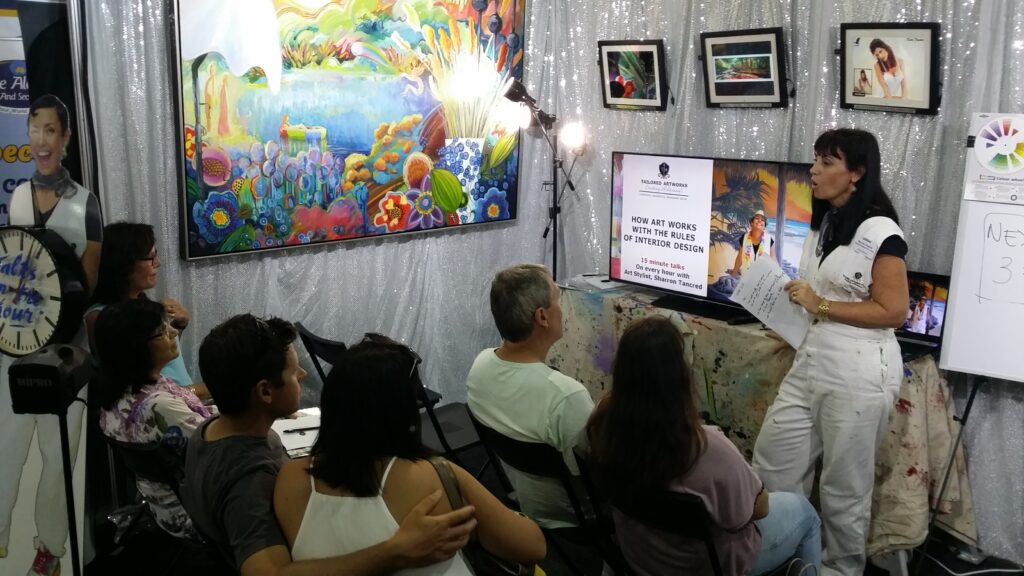
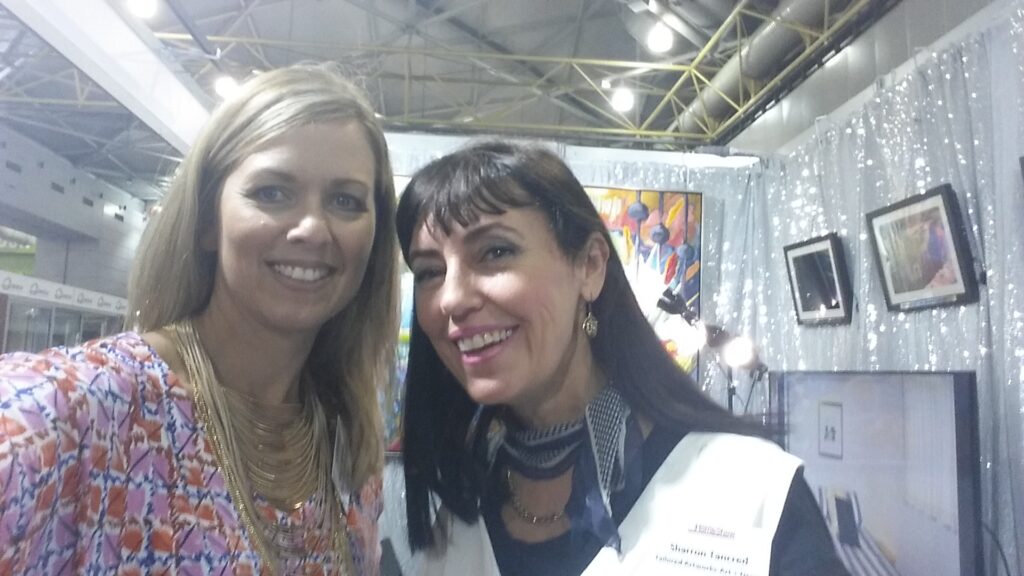
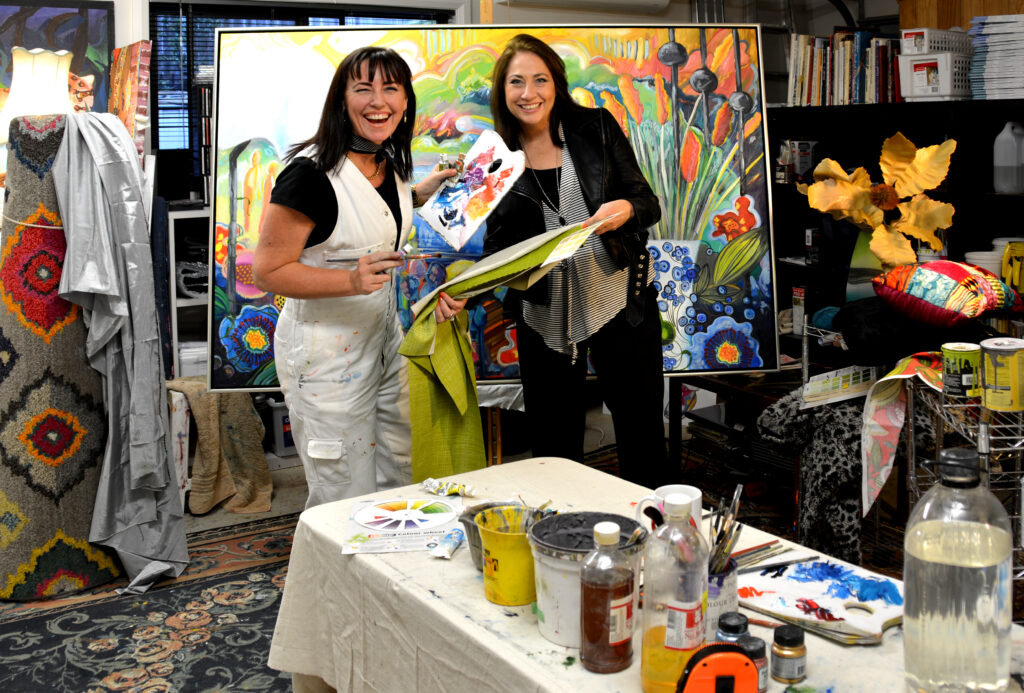
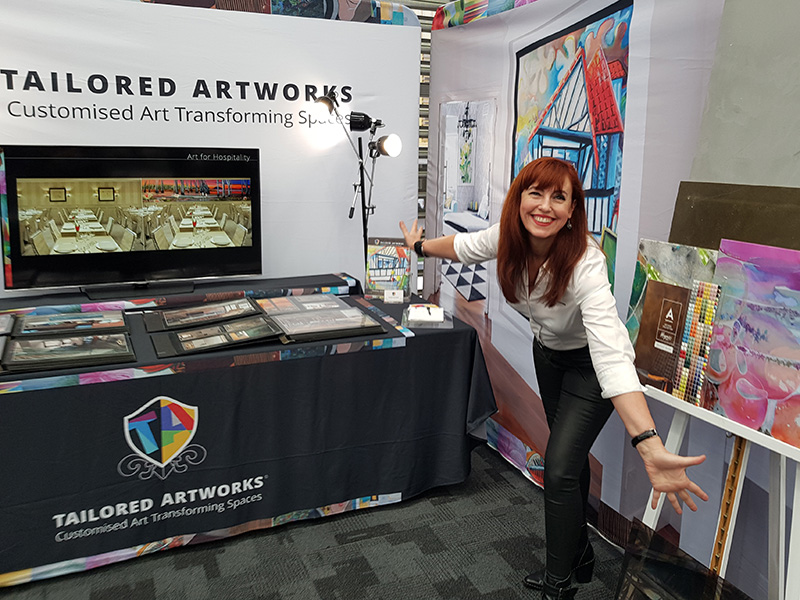
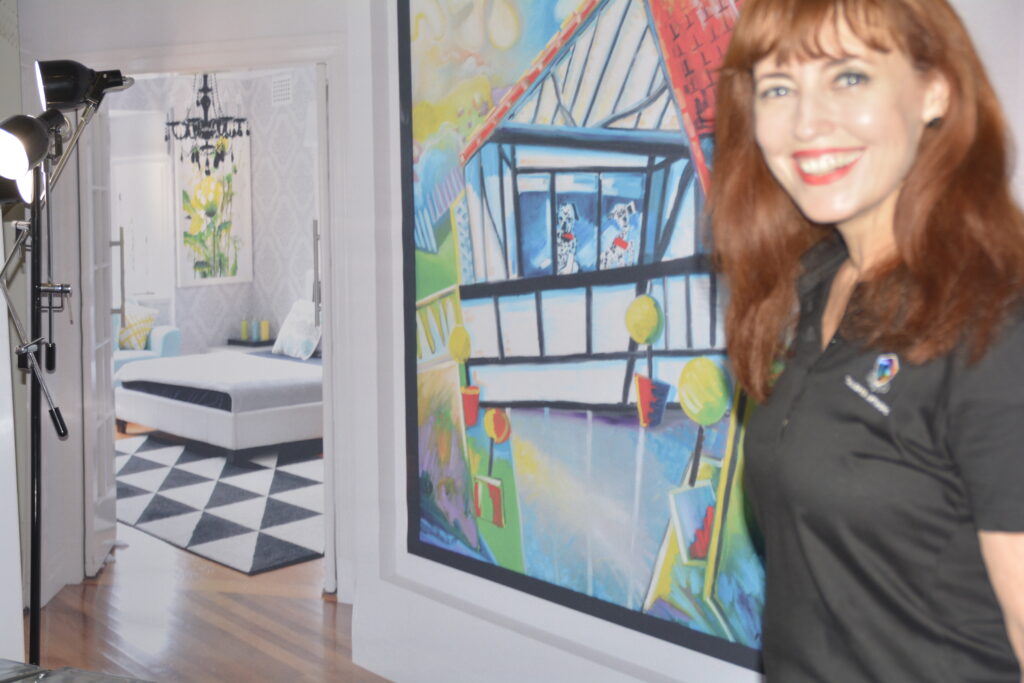
Experience. Now, the tailoring of artworks and murals to client decors proved to be very practical, and this led to another BIG idea. I hated the idea of people feeling disconnected from art because they didn’t understand it. I believe that great art can be created in just one day- especially with an assistant. I also think that everyone deserves a beautiful gallery-quality work of art that expresses their personality. How can people understand art if they never REALLY experience it in real-life situations? I began offering Private Art Workshop experiences. Clients painted with me and signed their masterpiece, loved their art, and it was designed with them to match the blasted couch!
Then came the Designers. I had built Tailored Artworks with help from wonderful friends and family who will forever have my gratitude. In March 2015, my interior designer friend Tracie Rodwell Dunne, joined me at my Brisbane Home Show and got work! Hear that penny drop!
Getting Awards and doing talks with friends and designers
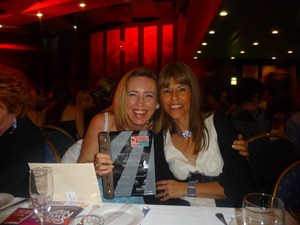


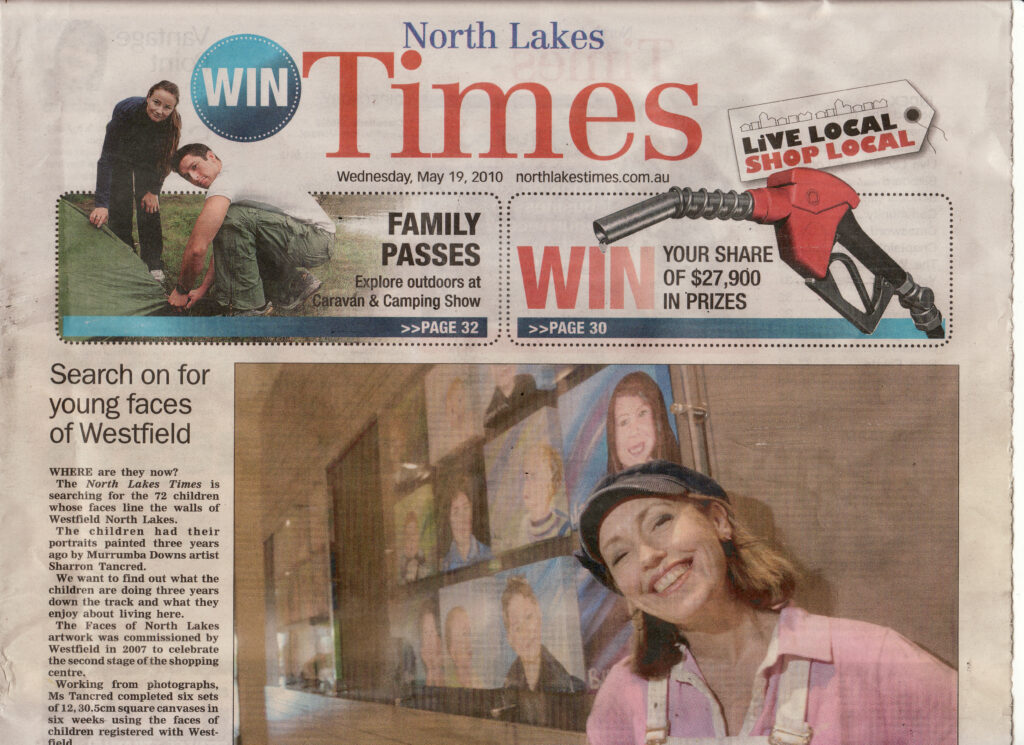


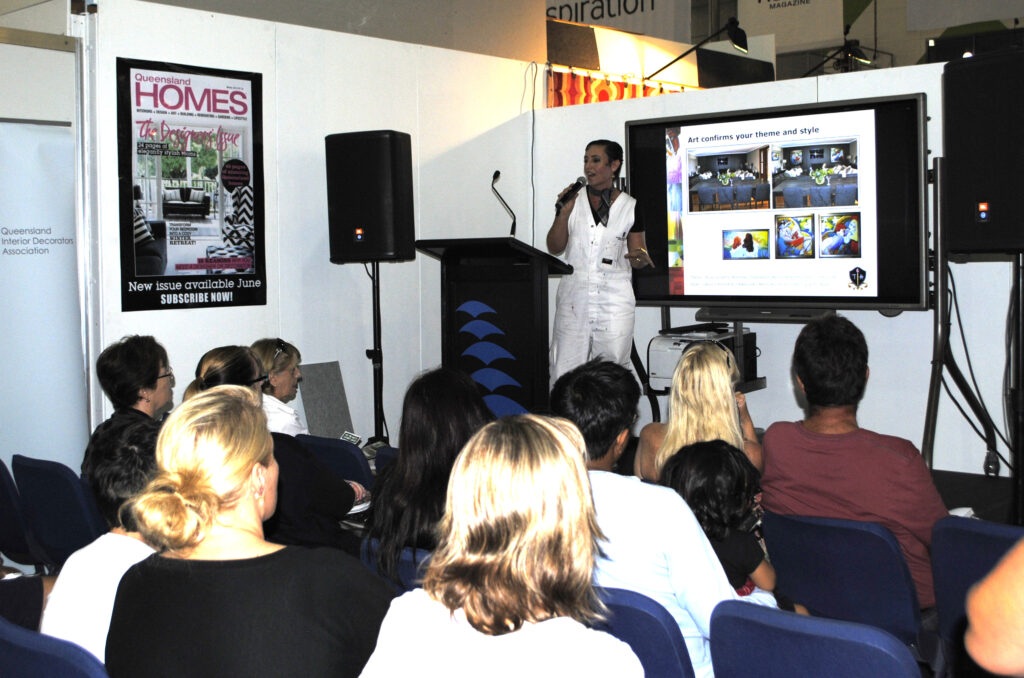
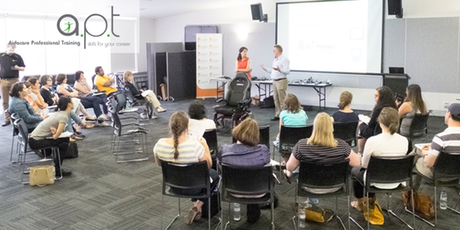

The roller-coaster ride! At every Brisbane Home Show, the Interior Designer-Decorators and I worked together with the vision to use art to inspire their home decors. This is what I had always wanted, and the clients LOVED this natural process. I had looked in the mirror and had changed my little part of the world. What is Art? What does Art do? It creates the soul of a home. But, the cost of the Brisbane home show kept rising and the number of days reducing.
A new Mission. After 20 Brisbane Home Exhibitions, I stopped them. I decided to start developing the products requested of me from 20 years of Home Show visitors. I was a member of the Queensland Interior Decorators Association (QIDA, now the IDA), sp I joined the Housing Industry Association (HIA), the Kitchen and Bathroom Designers Institute (KBDI), Arts Law Australia, etc. to increase my contacts, learn and ensure the right industry advice.
And so I became a ‘”’visionary inventor” with what I called, ‘Built-in Art Assets’. I didn’t even know they were actually called Design Finishes!
The Real Art Kitchen Splash-back story. So, I started not with printing, but with hand-painted splash-backs. Because people loved the idea of the paint textures and metallic effects. It took 6 months from September 2017 and 3 glass suppliers to perfect the Real Art Kitchen Splash-backs process. I researched paints, substrates, freight processes, and more to ensure our ‘Real Art Splash-backs”’ would be resistant to fire, mold, mildew, dust, bugs, and cracks as well as compliant with QBCC legislation. We installed my first one in just two hours without a hitch. I felt so proud!
So I got more ambitious! While developing my Real Art Splash-backs, I found a supplier who could digitize my artwork into Mosaics! In this way, we could cover anything with mosaic art and it would be waterproof. Then, I worked out how to hand-paint murals for Outdoor walls to save the expense of on-site mural work and allow clients to move the mural if they shifted house: Moveable Outdoor Murals. At this time, I was invited to become an Accredited Applicator for Haymes Paints Artisan range, I felt like it was all coming together as ways to decorate with art that lifted the vibe of spaces.
Then it hit me! An advocate introduced me to a printer who could print textures. That was interesting: textured printing. I thought ‘Fantastic! We can print art, so it looks like art, not flat mass-produced stuff, but real and wholesome’. Cool. My artist and decorator mind went to work and out came ’tile murals’ and ‘glass murals’ for built environments and, home renovations!
Tile Murals and Glass Murals = The Final Chapter … or so I thought. So, from art, to feature walls, to outdoor murals that could be moved, to custom mosaic to textured wall murals, and now art printed, flat, or textured onto tiles and glass. Instantly, work came in. I was helping folks with their whole house, solving their styling and problem-space issues with art products they could relate to. More and more art products for renovations!
Christmas 2018. Through the Interior Designers Association, I met a new printer with state-of-the-art HP print technology to print art onto films for splash-backs, wallpaper, and room door wraps. But I was the one doing all the organising, so that wasn’t sustainable… So I decided to create The Mural Shop online store. One international freight agent shipped all the products directly from the supplier to the client’s door. Direct fulfilment = no warehouse!
One day… I was in a bathroom pondering how dull the tile stripes were and bang: ‘Vertical Tile Feature Strips – budget-friendly accents to individualize the sea of white bathrooms’ were born which created the illusion of space and a feeling of well-being.
2022 The Mural Shop was now shipping our Unique Art Finishes to clients as far away as Florida and Perth. It wasn’t easy. During the pandemic, my printers couldn’t get their primers from China. I changed printers and then they changed direction. I found another printer but fell out with them. During the stresses of COVID-19 lock-downs, freight agents and couriers were throwing our products and breaking them! More parting of ways! But, I was rescued by a bigger printer who saw the vision and could do all the packaging and freight management – a blessing! During all of this, I developed more ways to help my aged care clients with printed Door Disguises and Wraps for Room doors and Windows. I formed a partnership with True Doors® in the Netherlands and expanded my network internationally through LinkedIn.
Help comes – from the government? I always knew how big the problems of unappealing and bleak facilities in the aged care industry were. To me, the suffering of our elders in the facilities was overwhelming. I felt hesitant to face this until one day, at a business group meeting, I met Klaus Veil. Adjunct Professor and International Health Tech Expert and Mentor/Coach to business people whom he felt he could help.
The timing was great because the government had just decided to implement the recommendations of the Australian Royal Commission into Aged Care – and Klaus convinced me that I already had the products to help them. Finally, the many years of research into What Art Is and What Art Does seemed to have had a purpose. Also, a third bout of tennis elbow from too many years of private art commissions and home renovations meant that my body was wearing out. It was time to stop all the physical labor.
From my home studio
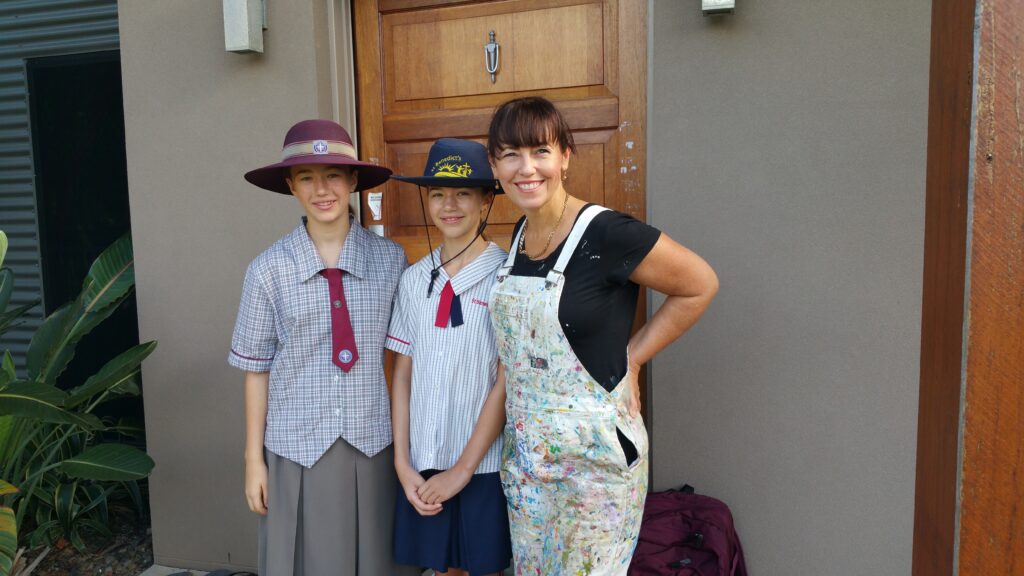
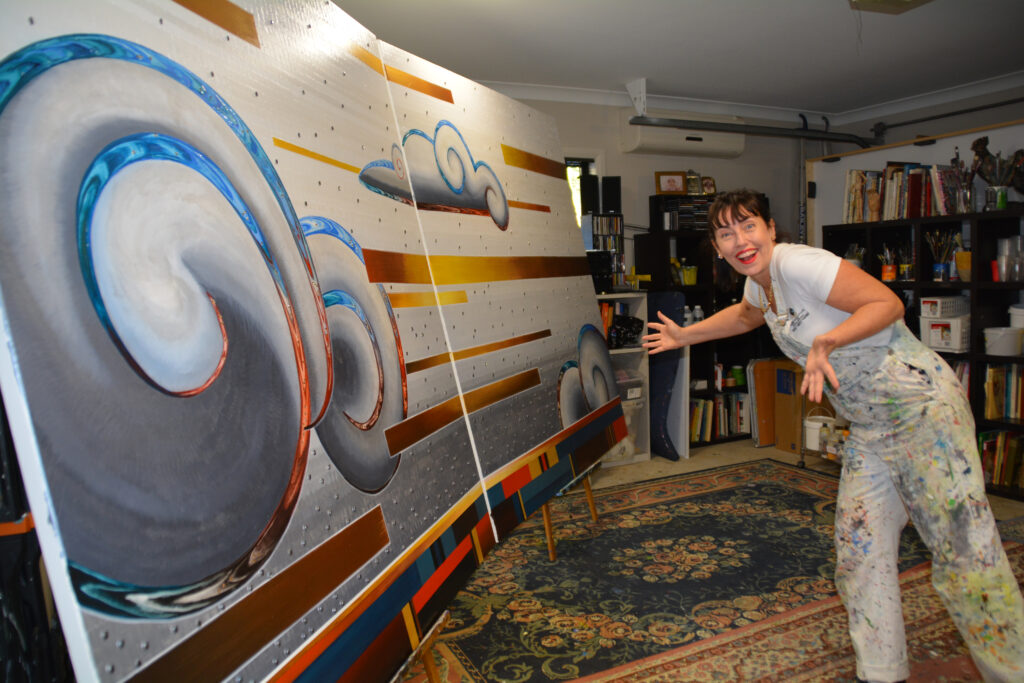
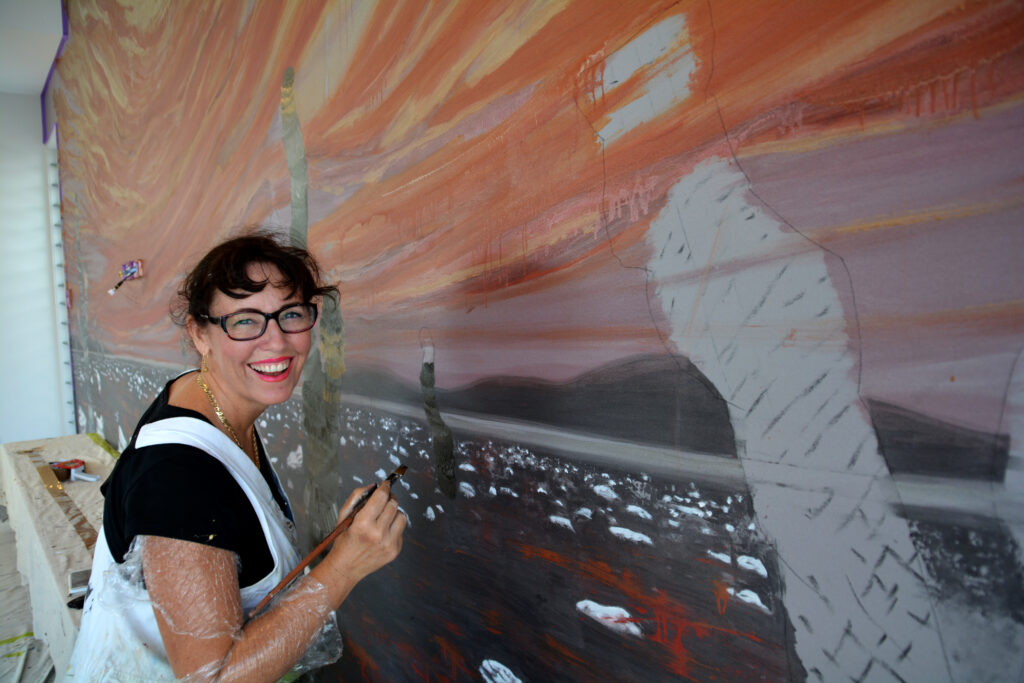
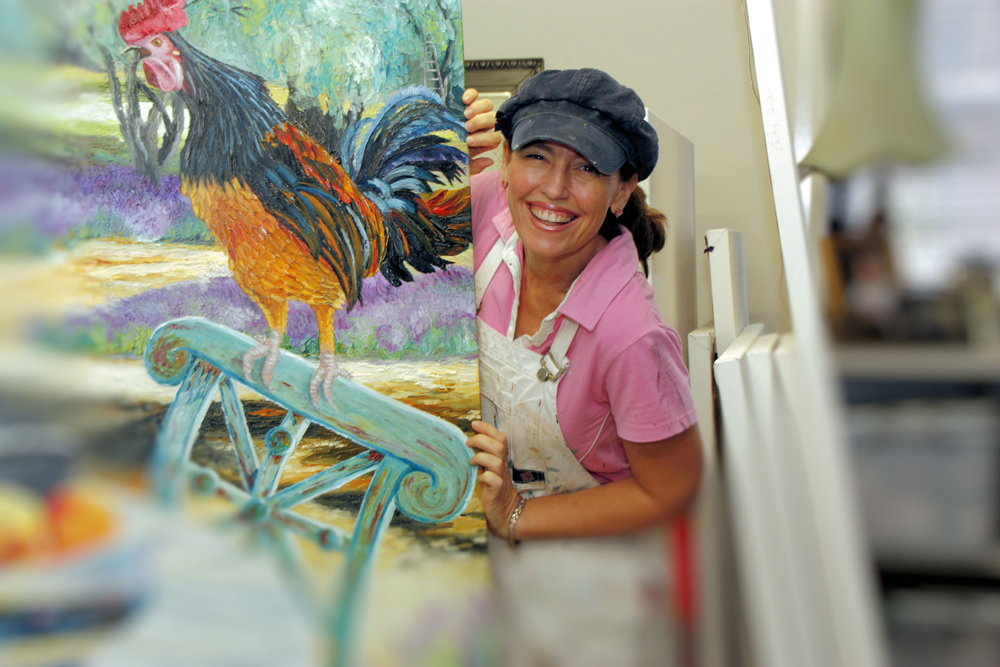



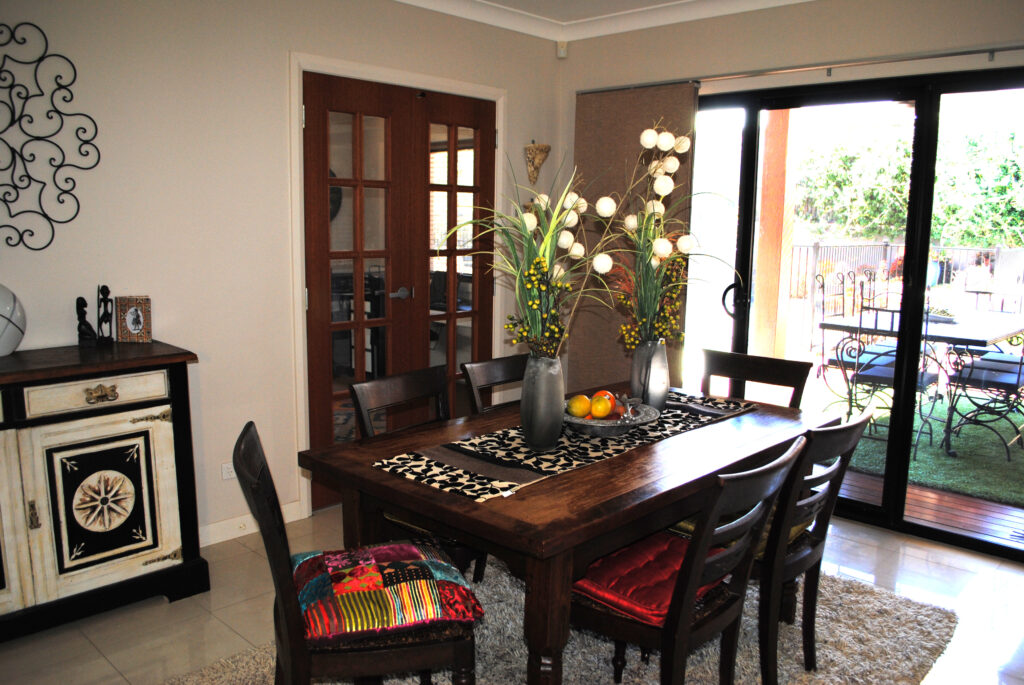
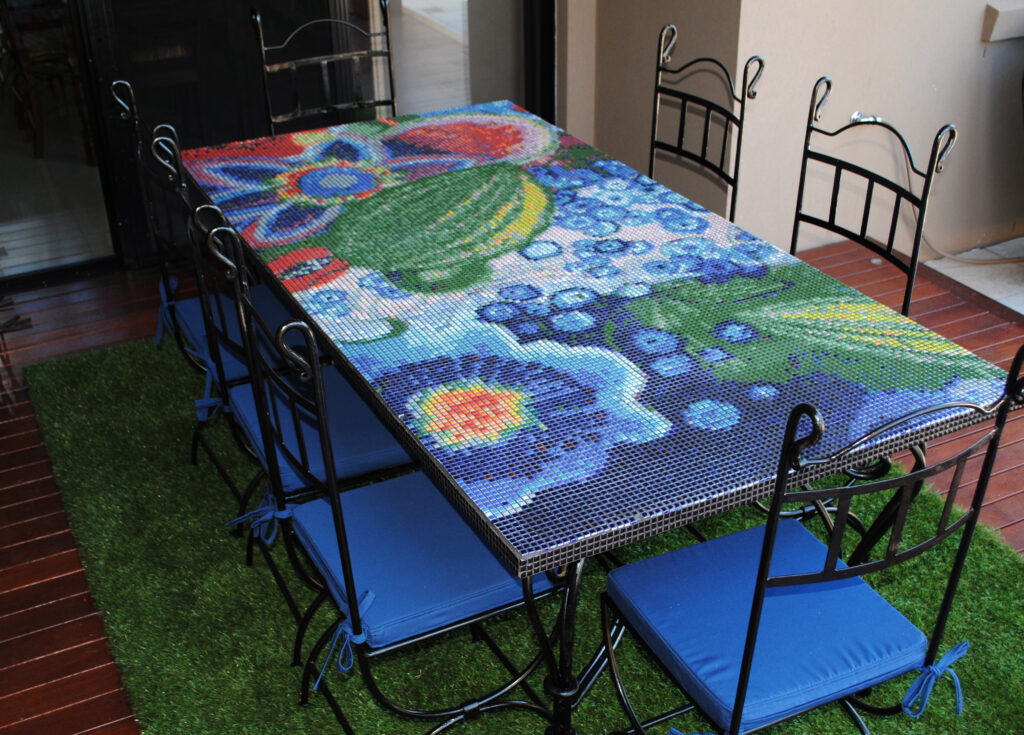

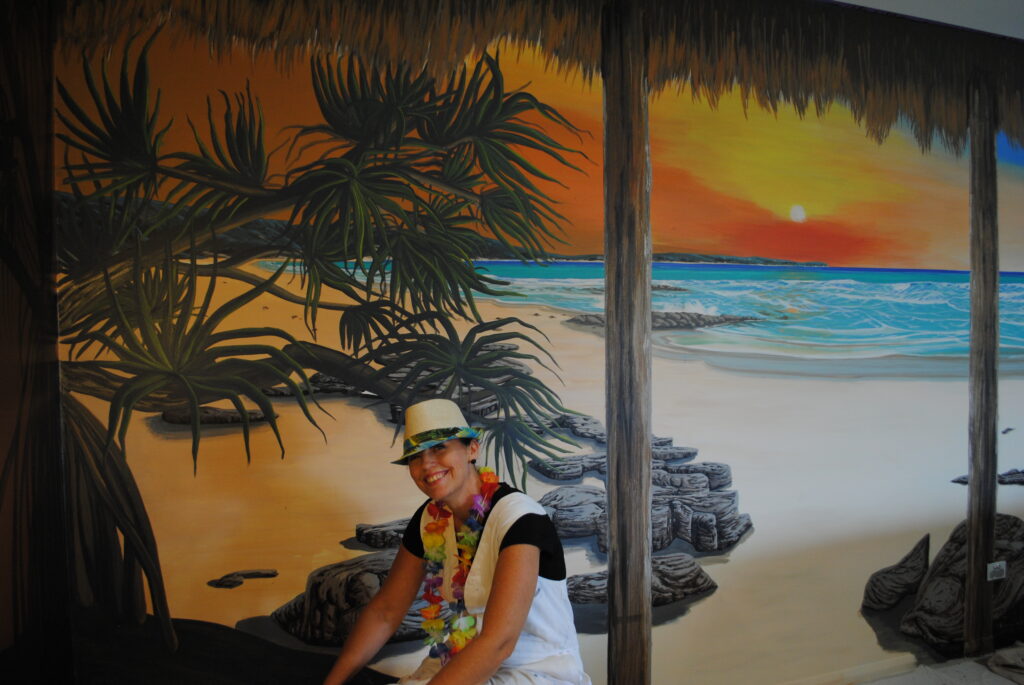
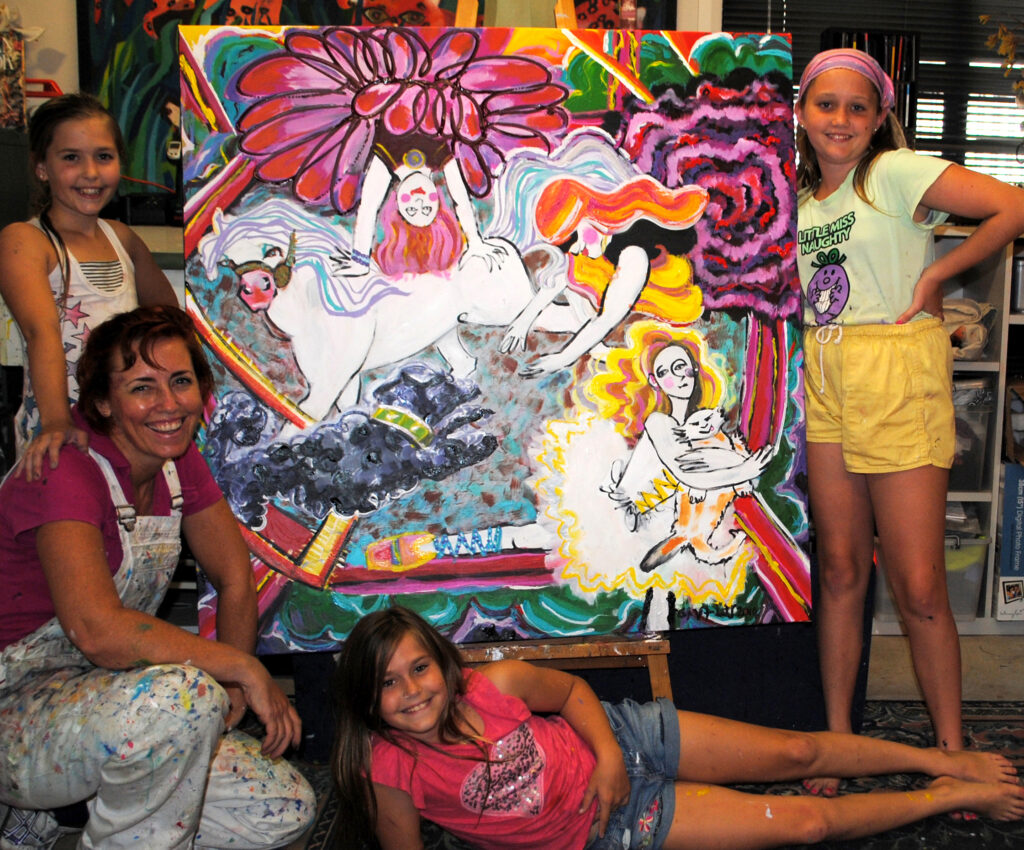


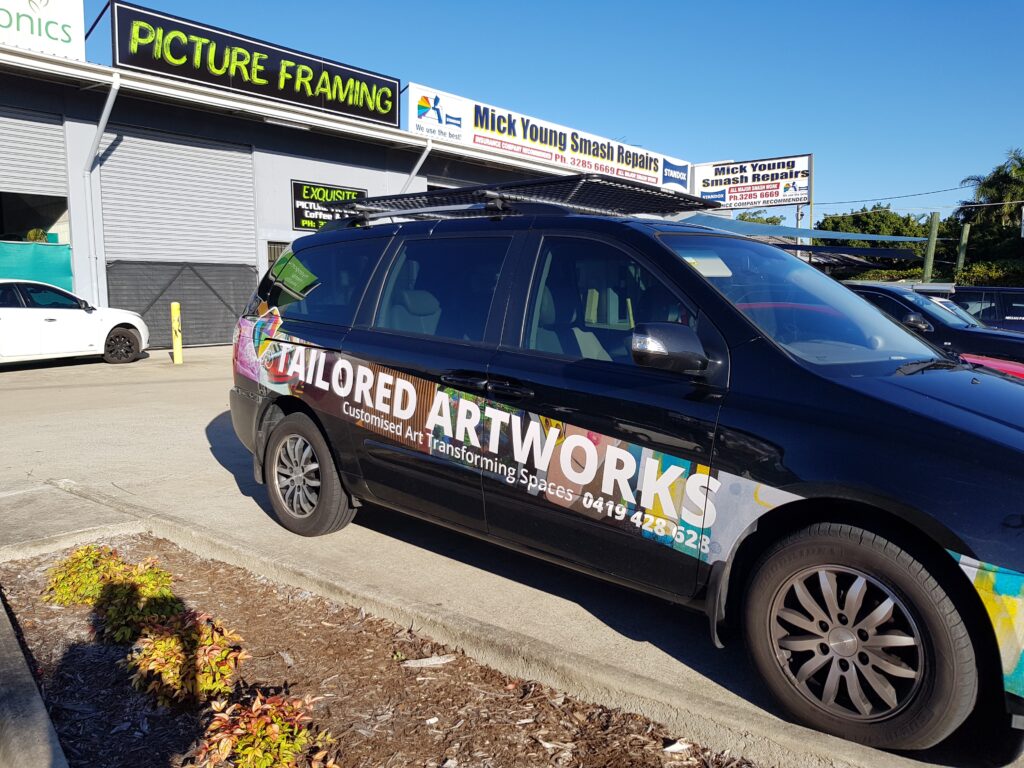
Reinventing my Business. In late 2022, Klaus and I began the process of re-imagining my brands and products to focus on Art for Health Care. We separated my products into ‘Tailored Art‘ to supply organisations operating aged care and health care facilities and the ‘Mural Shop‘ selling my retail products online. And it worked! Leads started coming in from as far away as Canada! I developed more products: Windows Out, Stained Glass Door Panel Inserts, Artful Signage. We aimed for the corporate market so providers could roll out products across their facilities and they responded. In 2023, we expanded into art for NDIS clients. Simultaneously realising that we also had a market in the cruise industry to assist with way-finding and luxury finishes for Wellness Design.
My goal is to continue to grow as I help convert bleak homes and facilities into spaces of well-being. If you would like to chat, please book a free discovery call!

The story of how Sharron developed her Healthcare Murals and Ethics
Focusing on purpose – Aged Care. In late 2022, I decided, with Klaus’ expert guidance to focus more of my time into corporate Aged Care. So, I began researching the sciences that contribute to good human design. Because, good design for dementia is good design for humans.
My expertise in Aged Care Murals and Environments Design for Dementia had began in 2008 with hand-painted Murals for Queensland Health under the guidance of a Leisure and Lifestyle Therapist. The next six projects of Aged Care Murals were for Regis Aged Care who educated me with their research into visio-spatial perception for people living with dementia.
My Aged Care Murals are strongly evidence-based. From this basis and as a professional artist, decorator, designer and product developer, I evolved Tailored Artworks to specialize in Murals for Dementia. I also became Wicking Certified in Environmental Design for Dementia, trained by Professor Richard Fleming at The University of Tasmania.
”VERY LITTLE RESEARCH ON MURALS”
In the 1980s, Professor Mary Marshall with Professor Richard Fleming rightfully noticed that there was extremely little research done on Environmental Design for Dementia. Sharron’s story continues…
Fighting the reputation caused by bad murals. The booklet, Talking Murals by Mary Marshall, is a discussion on the lack of research on murals for dementia. Unfortunately, the lack of research created the directive to paint a doors the same colour as walls, or with a stripe to suggest one cannot get through. Instead, this has created demand. My experience, Wicking Certified Training combined with the latest science to achieve evidence-based Wall Mural Design for dementia has derived in part from the booklet’s points – as evidence-based research, on what not to do, based on its examples by other companies: photo murals by printers and vector murals by designers, seemingly with little knowledge of dementia.
Professor Richard Fleming and Kirsty Bennett from the University of Wollongong formed most of the advice in Australia on Dementia enabling environmental design, creating the 10 Dementia Enabling Environment Principles. They “come from reviewing research literature of studies looking at maximizing enablement and well-being through physical design for people living with dementia.” As you can see, Wicking advises the use of Door Disguises.
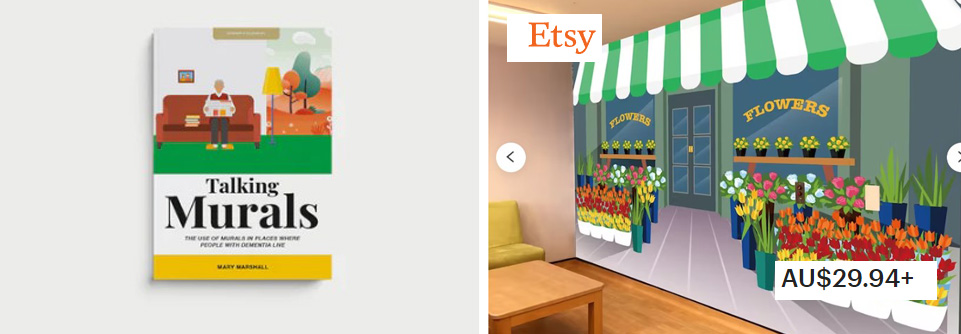
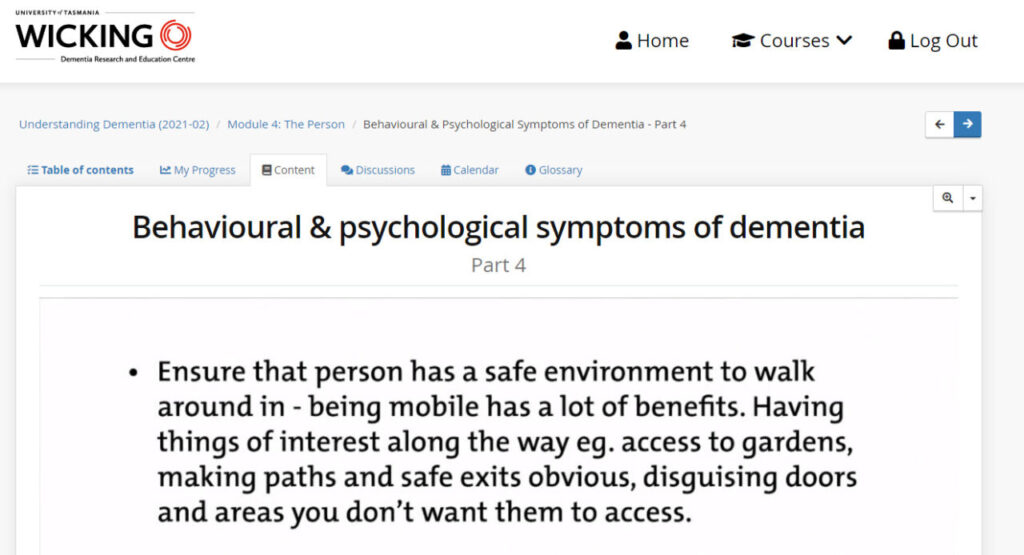
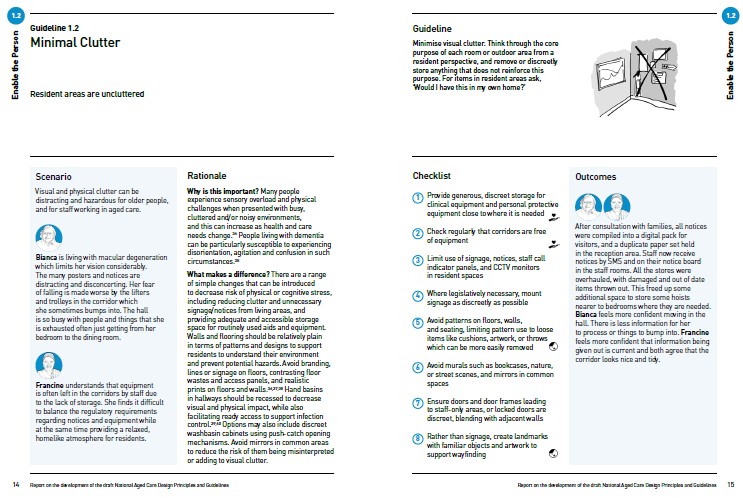
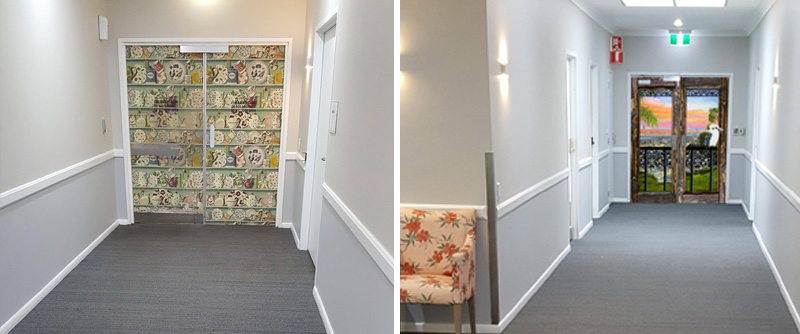
Art becomes the government’s go-to in Aged Care design. In 2023 architects Liz Fuggle, from Hammond Care, and Nick Seeman with the Australian Government, AHSRI and the University of Wollongong published the Final Report on the development of the draft National Aged Care Design Principles and Guidelines. Bookcases encourage people to stand at doors which is futile and unsafe. Photographic nature scenes look commercial and their psychology can cause falls. We believe that art showing a view out, with the psychology of I can see there but not go there, whether as a balcony, window view or artwork, is best.
While art is now regarded as best-practice for landmarks for wayfinding, they went back to painting door the same colour as walls, which as explained above, continues to create demand for me to create more door disguises! So the question is, not what they are, but how they are done.
ART VS PHOTOGRAPHY, NATURE VS SHOPS
Scientific evidence says that nature is better than shops and that art is as powerful. In this way, I believe that art is better than photography or vector graphics for biophilic design and salutogenic design, for a more home-like design- for anyone, anywhere.
All of the research principles favor access to nature, meaningful and contrasting colours.
Watch this webinar with Dr Pamela Topping on Strengths-based Design using Colour, Murals and Door Wraps.
Truth vs Need: Professor Richard Fleming from Wicking, University of Tasmania and the University of Wollongong, who retired in 2022 is the Australian Government’s leading expert in dementia design. His guide to environmental design for dementia said nothing untoward about Murals.
In an effort to avert from bad murals to disguise doors, Dementia Training Australia in their Resource 2: Applying the Key Design Principles in Environments for People with Dementia, (also written by Richard Fleming and Kirsty A Bennett ) suggested painting a stripe across a Fire Exit door in Memory Support Units.
Times have changed. Today, we ask this question: The new 5 Star Ratings for Australian Aged Care rewards uplifting environmental experiences. Therefore, how does a hospital-style door stripe help Institutional-style residences to be more Home-like? It is important because good design can reduce a person’s depression.
Architect Jan Golembiewski writes in his article, “Turning ‘human-centered’ design for aged care into reality”, Design for Dementia is scarcely mentioned in The Australian Royal Commission for Aged Care.
DOORS AND STRIPES – INSTITUTIONAL DESIGN VS ART:
One of my Aged Care provider clients in Queensland followed the above advice and painted a stripe across their Fire Exit Door.
I quote, ”It had little effect on residents in our Memory Support Unit. They were still banging on the door to be let out.”
Another Aged Care provider with 15 facilities in Queensland, commissioned me to custom design a Door Disguise for Dementia in consultation with them for their facility. Our clients achieved immediate benefits in terms of no more banging and improved morale from residents, staff and visitors. We are on their project within as many months. They are now getting data to help gain funding for more projects with us.
It was at this point that I met Tara Quirke, my client’s facility assessor, who it turned out, had been recommending Tailored Artworks to her clients. Very honoured!
Tara is a top Australian Facility Assessor who works as a National Dementia Consultant and for a large National provider of aged care services; previously worked as a Senior Environmental Design Consultant with Dementia Training Australia; was a registered nurse and with a Masters degree in Clinical Nursing (Gerontology) and a Masters degree in Mental Health and Aged Care Quality Assessor with the Commonwealth Government. Tara and I met over a long lunch and began, slowly, to collaborate. Providers are obliged by law to carry out Continuous Improvements provided through reports that facility assessors like Tara write. However, Tara was frustrated with her directions being sent to printers who knew nothing about dementia – and whose murals created more problems. I learned from Tara and she from me, shared by our love of good wine, honest approaches to life and our genuine lifelong passions to be change makers.


AWE THEORY
Today Tailored Artworks custom-prints and installs our beautiful art innovations Australia-wide. We use Awe Theory, Room With a View Study focusing on nature, The Eden Alternative which focuses on Strengths-based Design, Risk Attitude, Colour Psychology and more.
As such, the results do not deprive our elders living with dementia in Residential Aged Care Homes, of colour, multi-sensory environments or gentle reminiscence.
In a white paper, prepared in 2028 for the John Templeton Foundation by the Greater Good Science Center at the University of California Berkeley, Summer Allen, Ph.D. writes: ‘A number of empirical studies have explored the types of situations that can elicit awe. For example, studies have found that natural scenes are frequent awe elicitors, that stimuli do not need to be physically large to elicit awe, and that recalling spiritual and religious experiences can evoke feelings of awe.”
When I discovered Awe Theory, I immediately bought the book. Awe encompasses nature, the arts and art. In the National Aged Care Design Principles and Guidelines, art is vital for landmark wayfinding. I had already innovated our Windows Out product which Tara said was ideal for dementia. Especially dementia with Lewy Bodies because Windows Out, being flat and glassless, removed the problems of glare and reflections that can cause stress.

THE ULRICH 1984 ROOM WITH A VIEW STUDY
(View through a window may influence recovery from surgery, study):
Art and murals in Aged Care Environmental Design, done right, can engage the same feelings of awe resulting in the same physiological benefits: the stimulation of positive endorphins that in turn release dopamine which lifts people’s spirits.
As a result, hospitals began to embrace biophilic design and then biophilic art and now salutogenic design. Because, this sensation brings the wonder of nature into their environments for well-being.
Here’s a good question for facility managers: Do you ever get a resident who asks how can I get out to go shopping? We got ONE request recently.
It is rare because people ask, how can I get out – as in to be in nature? In short, the results of Ulrich’s study, “imply that hospital design and site (design) decisions should take into account the quality of patient window views’ in that, ” in comparison with the (brick) wall-view group, the patients with the tree view had shorter postoperative hospital stays, had fewer negative evaluative comments from nurses, took fewer moderate and strong analgesic doses, and had slightly lower scores for minor post-surgical complications.”
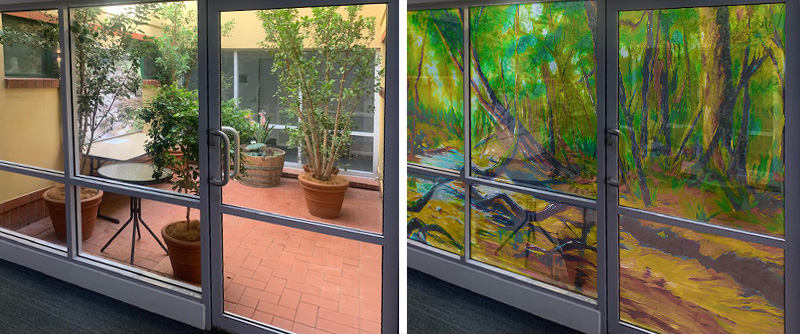
RISK ATTITUDE
Currently, and Internationally, there is a strong trend by architects to move away from Memory Support Unit model to more open, gated communities like Hogeweyk in the Netherlands or The Green House Project which started in Mississippi, USA.
Memory Support Units are a reaction by regulatory bodies toward Risk Aversion that treat an entire population as one.
In the past, providers took Risk Aversion to the extreme to keep people living with dementia safe. For instance, tied into chairs and drugged- until the Untie the Elderly movement (Washington Post) ended the practice.
Risk, or Peril is defined as ”possible danger with implied safety”. Yet, removing all risks from a person’s lived experiences can lead people to very extreme behaviors. Because we need a little risk in our lives to give us a Dopamine hit to the brain that feels good. For instance, leaning into a balcony above a height feels thrilling.
I wondered, could Awe Theory, Room with a View, Risk Attitude, and Biophilic and Salutogenic Design unite through the Age-old Importance of Art in Architecture to improve Mental Health in Aged Care environments? The answer was, resoundingly, yes! We can mitigate risk and give a little risk without killing off multi-sensory experiences. Tara Quirke and I chatted about all of this over wine and a long drive to one of her clients. It was all coming together.
Risk Attitude is expressed nicely by Amy McDunna (United Active Living, United Minds, Butterfly Model programs, Calgary, Canada) in this Podcast by Perkins Eastman, “Shaping Dementia Environments”.
Amy tells the story of a resident who had grown up in the mountains, was struggling to settle into her new environment, and kept asking to go home. At the 10.31 Marker, Amy said that by explaining to the family the benefits of a little risk it was agreed to take the loved one to a museum where there was an exhibition on the mountains. Whereby they took a photo of her smiling in front of a MURAL of mountains.
We ask, did the provider then add a mural of mountains to the home’s environment? The answer is usually no.
I decided to research age vs dopamine.
I found this explanation from the University College of London repeated in Neuroscience News
‘The steady decline in risky choices with age matches a steady decline in dopamine levels.
Throughout adult life, dopamine levels fall by up to 10% every decade.’
So, Risk Aversion is a natural part of ageing and yet, having no risk doesn’t make a person feel like they are living better, only longer.
Risk is linked to serotonin and dopamine in the fight against Depression. Although a lack of dopamine alone may not directly cause depression, having low levels of dopamine low levels of dopamine may cause symptoms that health experts associate with the condition. These symptoms can include:
– lack of motivation
– difficulty concentrating
– feelings of hopelessness and helplessness
– loss of interest in previously enjoyable activities

2023, I was invited to join a team of Aged Care Architects to test the
Government’s Final Draft of the National Aged Care Design Principles and Guidelines
which lead to a QUT Industry Partnership for NORCs
In late 2023, after publishing my research in LinkedIn posts and articles and building my network, I met a very kind gentleman at the First Thursday Club called Peter Jensen. Peter wanted to unretire from his successful career in Facility Asset Management. He introduced me to Alan Cubbon from Crosier Scott Architects.
Alan invited me to collaborate with him and his lead architect Shilo De Bono in the government’s, “Reminaging Where We Live – Design Ideas Competition” to test the draft of the National Aged Care Design Principles and Guidelines. So excited!
I then invited Tara Quirke.
Tara invited Tara Graham-Cochrane top landscape architect from DesignWELL, and we had our team.
I was now where I was meant to be as a thought leader in environmental design specializing in art and murals as evidence-based and strengths-based design for dementia.
The competition will be drawn in April 2024. We’ll let you know the results!
The architects called our building, ART HOUSE – which we discovered is a NORC-SSP: Naturally Occurring Retirement Community with Supportive Service Program. Then, QUT’s Dr Bo Xia, a Professor in the School of Architecture and Built Environment at Queensland University of Technology, invited me to form an industry partnership. Bo’s review of the 50 worldwide studies done on NORCs follows his research on construction management, sustainable buildings, and age-friendly built environments for older people.
The Baby Boomers are turning 80 in the next ten years inside of a global ageing population and increasing rates of dementia, including younger onset dementia. Unlike their parents, Baby Boomers are reluctant to enter residential aged-care housing. NORCs that offer culture, community and accessible health care services in their building and outside of their apartment are their desire. Because, Art creates culture. Culture creates community. Community creates humanity (S. Magsamen). See Art House.

A discussion on Aged Care Design Guideline 1.1 Personalised Home – Checklist 3 – Promote resident’s culture using personal objects and art in COMMON areas, with no single culture or person dominant
Wayfinding cues review proves stability, nature-like colours and textures in art and objects outside of rooms and landmark pictures work best.
We are curious to hear from you if nurses playing decorators with resident’s art and objects works?
The ‘Creating a Supportive Environment using Cues for Wayfinding in Dementia‘ Review investigated ”salience and complexity environmental cues in place learning tasks for 20 older and 6 younger women to repeatedly wayfind a hidden target in 4 virtual environments:
1) Simple salient: 4 pictures of black and white objects as cues
2) Complex salient: colorful and textured pictures
3) Nonsalient: 2 black and white abstract pictures
4) A control condition: Similar to the simple salient condition except for the cues changed locations among trials
Results showed the effects of age and cue condition:
– Younger subjects were faster and more accurate
– All subjects found the hidden target the best in the complex salient cue condition
– The older adults had a much worse learning curve in the non-salient cue condition (where items changed)
This study supported the proposition that older women may be more reliant on colourful and more numerous cues than younger women.
Another study of salient cues at key decision points on people with and without dementia used VR across 2 environments comparing no purposeful cues and salient cues of bright, colourful, big and memorable cues i.e. balloons, rainbows, flags, and animals. Both groups wayfinded faster and more frequently with salient cues.
So, there is early, but consistent evidence that it is possible to make environments more memorable to support wayfinding using bold, colorful, familiar, meaningful, and distinctive cues.
The Final Draft of the Australian National Aged Care Design Principles and Guidelines: 1.2 Minimal Clutter directs the use of objects and art to support wayfinding but in 1.1 asks providers to use resident art and objects.
The reviews’ room door recognition studies show improvements of:
– 50% from a portrait and name sign on their door
– 45% from a memory box with pictures and meaningful memorabilia
The latest science of neuroaesthetics has proven that Beauty when emotional and practical as landmarks creates saliency (Magsamen, Ross, Your Brain On Art, 2023). i.e. Beautiful naturally colourful textured art
The review’s example picture is not textured. Art is textured, and in decorating art warms a space and creates a homely vibe – which is the goal.
Do you agree with us that:
1. Constantly changing landmarks will create confusion?
2. A population’s eclectic artworks and objects will create clutter?
3. Staff trying to decorate with residents’ belongings will cost time?
Connect with us on LinkedIn and post your experience!



Awards and Achievements
2024
– Collaboration with Queensland University Technology (QUT) School of Architecture, Professor Bo Xia
– Invited Speaker – International Dementia Conference, 5-6 Sept. 2024, Sydney, Australia
– Invited Speaker – International Conference on Dementia, Alzheimer & Neurology (DANC 2024), October 25 & 26, 2024, Dubai, UAE
– Joined Places For Ageing Committee
2023 Invited to collaborate with Crosier Scott Architects in the government’s: ”Reminaging Where We Live Design Ideas Competition” to test the draft of the National Aged Care Design Principles and Guidelines
2022 Nominated for two awards by The Interior Designers Association:
– HIA Awards Finalist, Professional Women in the Aged Care and Dementia Space
– HIA Award nomination, Advanced Manufacturing Award in the Aged Care and Dementia Space
2022 Partnered with True Doors® – The Netherlands
2021 WICKING Understanding Dementia Certificate – University of Tasmania
2021- 6 week course, Mindvalley Education. Silva Ultramind- problem-solving using Altered States
2019-20 Online Marketing Course – Not So Freaky University
2018 Certificate Accredited Applicator – Haymes Artisan Paints
2017 QLD HIA Award Winner Interior Design (supplier) with New Leaf Design Studios
2017 Finalist, Excellence in Advanced Manufacturing – Moreton Bay Regional Business & Innovation Awards (MBRIT)
2017 Nominated Moreton Regional Council Business Awards for Excellence in Customer Service
2015 QLD HIA Awards Finalist with New Leaf Design Studios
2012–20 Public speaking – “How Art Works with the Rules of Interior Design” and other talks for Queensland Homes, Brisbane Home Show, The Build and Design Centre (South Brisbane), Queensland Building Designers Association, TAFE Colleges, Moreton Shire Regional Libraries, Commercial Art Training Centre (CATC), Art Land, Queensland Interior Designers Association (QIDA)
2011 Professional Member – Queensland Interior Designers Association (QIDA)
2010 Nominated, Regional Achievement Awards
2010 1st prize, retail section, Pine Rivers Quest Business Achiever’s Awards
2009–20 Published in Courier Mail, Sunday Mail, Home Show magazine, Queensland Homes Magazine, North Lakes Messenger, Quest Newspapers
2009–20 Exhibitions, Courier Mail, Sunday Mail, Brisbane Home | HIA Expos
2009 Highly Commended – Regional Arts and Culture Achievements Award
2008 Nominated, Best New Local Business
2007 Certificate Colour Psychology
2006 Highly Commended Award, “the most innovative and emotionally engaging business” – Small Business Success Story Competition, Pine Rivers Shire
2006 Certificate Interior Decorating
2003-05 Artworks sold at Auctions
2002-04 Silver / Gold Australian Catalogue Awards for Illustration of Grape Liquor Markets Catalogues
1996 Diploma Graphic Design (Digital)
1987 Diploma Graphic Design (Traditional) & Commercial Art Training Center (CATC) & Gold Award for Illustration & Graphic Design
1986 BA Illustration – Queensland College of Art, Australia
1984 Senior Art Award – Clayfield College, Brisbane, Queensland, Australia


